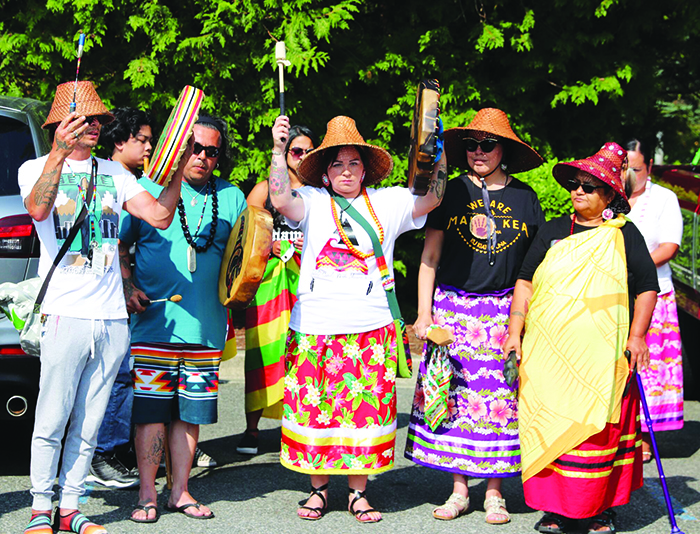
By Kalvin Valdillez, Tulalip News
Miles away in Hawaii, thousands of Native Hawaiians created a barricade blocking the only road leading to the top of Mauna Kea. The elders, or kūpuna, are bravely positioned at the frontlines, peacefully preventing the construction of an 18-story, thirty-meter telescope (TMT). The stand is now in its third week and Hawaiian activists, and many supporters, continue to hold their ground, protecting the highest peak in Hawaii, the sacred mountain Mauna Kea.
“We are protectors, not protesters,” exclaimed Native Hawaiian and Director of Equity for the Mukilteo School District, Gerry Ebalaroza-Tunnell. “Protesting has such a negative connotation, we want to set the space and let people know that we are coming to this place based off kapu aloha, because we just want to bring awareness to what’s going on.”
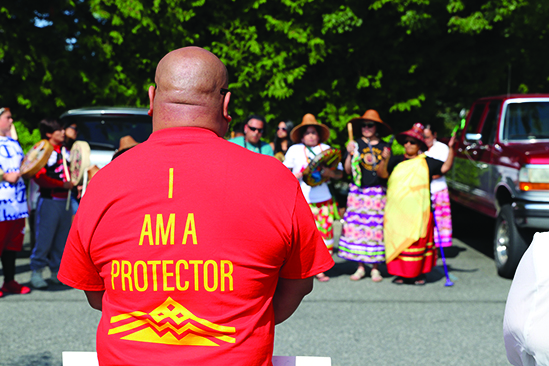
Over one hundred Tulalip community members and local Hawaiian families met at the Marysville Haggen parking lot on the morning of August 3. Several Saturday shoppers made their way to the backend of the lot to see what was going on, just in time to witness a cultural exchange as the Tulalips and Hawaiians offered songs and words, each in their respective languages. The crowd received a handout with lyrics of Hawaiian songs as well as ‘ōlena, also known as turmeric, both in powder and plant form. The Hawaiian community then performed a ceremony for protection complete with hula dancing and pahu drumming.
“The reason we do protocol together beforehand is because when the dominant culture sees a bunch of brown people together, they see us as protestors, as trouble,” explained Gerry. “So, we came together this morning for protocol to pray and sing and call upon our ancestors from all directions to protect us while we’re out bringing awareness. It was amazing to see the elders coming together and acknowledging each other, the land we’re on and why we are here.”
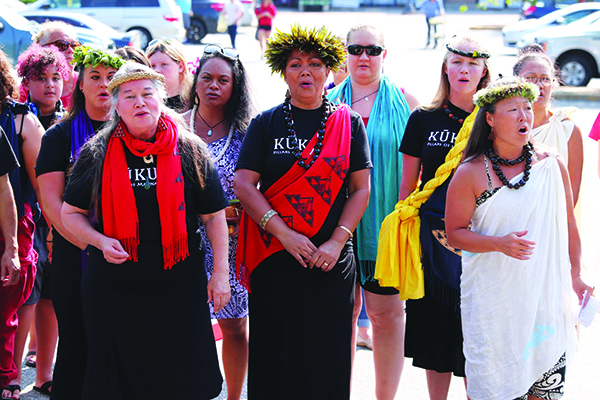
The fight to defend Mauna Kea has recently gained national news coverage as Hollywood actors Dwayne “The Rock” Johnson and Jason Momoa, as well as reggae musician Damian Marley, visited the kiaʻi (protectors) of Mauna Kei. Although the news may be new to some, the Native Hawaiians have been actively opposing this particular project for nearly a decade. The kia’i celebrated a victory in 2015 when the Hawaiian Supreme Court repealed the permit for the construction of the TMT. Last October, however, the Supreme Court of Hawaii delivered a new ruling which allowed Hawaii’s Board of Land and Natural Resources to issue another permit to the TMT group.
Hawaiian Governor David Ige announced this past July 10, that construction of the telescope would commence on July 15. The kia’i immediately sprung to action and assembled on Mauna Kea. After halting the construction for three straight days, the Governor issued an emergency proclamation which granted law enforcement more authority to begin making arrests. Heartbreaking footage shows the first arrests of the kūpuna, the Hawaiian knowledge keepers who volunteered to be at the frontlines, take place.
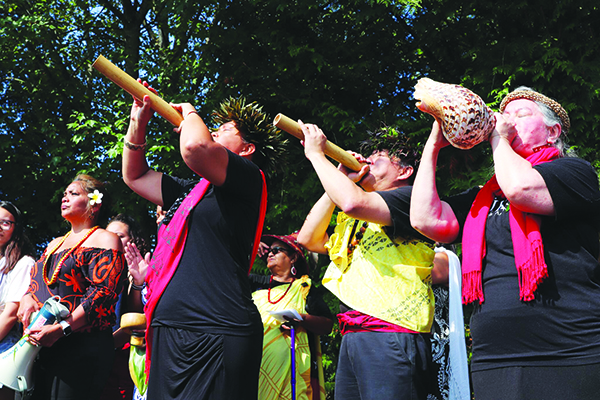
Elders who needed the assistance of wheelchairs or walkers had to be escorted to the squad cars by their own family members and those kūpuna who refused to leave were cuffed and carried out by multiple officers. The tears of the elders pulled at the heartstrings of those watching and hundreds of supporters begin to arrive daily to protect the sacred mountain.
If you measure the one-million-year-old dormant volcano from its underwater base, the sacred Hawaiian mountain is over 33,000 feet in total, making it the tallest mountain in the entire world. Because of its high elevation, the mountain has attracted a number of astronomy research groups. In fact, several observatories have already been established on the mountain since Hawaii became a state in 1959.
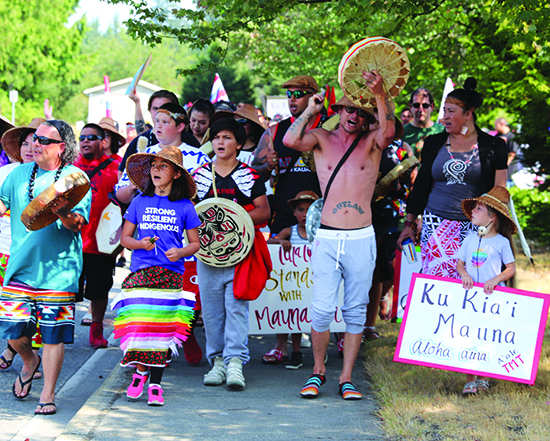
According to numerous reports, the land where Mauna Kea is located, was originally stolen from the people and then later obtained by the United States government. Through the Statehood Act, the state of Hawaii received the rights to the land which has since been managed by its current lease holder, the University of Hawaii. The university pays the state of Hawaii one dollar a year and in turn subleases the land to each observatory for a dollar. The TMT in particular is a $1.4 billion project designed and developed by the TMT International Observatory LLC (TIO).
“Being an Indigenous scholar in western academia and seeing them trying to build the TMT in the name of science, I don’t see the science they’re talking about,” Gerry expressed. “The science I look at, and I think many people here do as well, is the connection that we have to the land. What we’re doing today is gathering together, because there’s strength in numbers, to bring awareness to the desecration of our sacred lands. The more awareness we raise, we’re hoping it will put more pressure on those who are wanting to desecrate our lands and get a seat at the table to be a part of the decision and the discussion, because for too long they’ve tried to silence our voices.”
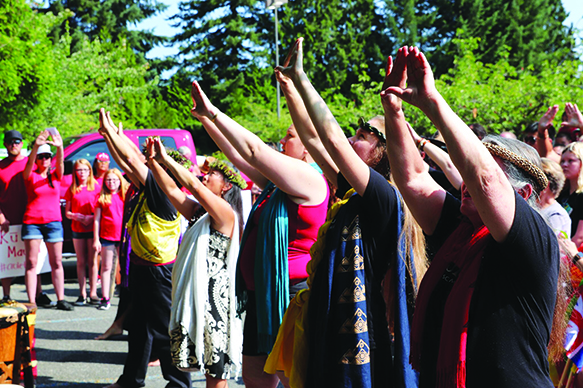
With dual-sided flags waving high, one side an upsidedown Hawaiian state flag and the other the Kanaka Maoli flag, the large crowd made their way from the Haggen parking lot to the I-5 overpass between exits 199 (southbound) and 200 (northbound). As the local protectors marched, they held up signs reading, We Are Mauna Kea, Defend the Sacred and Tulalip Stands with Mauna Kea.
The fight sounds all too familiar to the Indigenous peoples of America who share many experiences of the U.S. government exploiting Mother Earth for profit and colonization. But perhaps the reason the Mauna Kea movement resonates and has an amazing amount of support from Native Americans is because the mountain top is sacred to its local populous. That should be reason enough for construction to stop indefinitely but unfortunately the Hawaiians are now being asked to define what sacred means to them exactly.

TMT developers wish to build the telescope on the northern plateau of Mauna Kea, an area described by the kai’i as untouched, pristine land in which many villagers and residents of surrounding islands visit solely for the purpose of spiritual work, where they perform rituals for healing and have conversations with the higher power. The plateau also overlooks the river that provides the water for the majority of the island. The protectors have concerns that the giant telescope would negatively affect their water supply and local marine habitat. Most importantly, the mountain is a living spirit that has been a major part of Hawaiian history since the beginning of time.
“I’m originally from Hawaii, my family is from Hawaii,” stated Mauna Kea Rally Organizer and Tulalip community member, Absyde Kaiulani Dacoscos. “Since I can’t be there physically, I was trying to figure out how I can show my support and I started going to nearby rallies in Seattle. Something called to me, I knew in my heart I needed to do something here to show support. With the help of my cousin Gerry, Natosha (Gobin) and Sara (Hart), we put this together. This is not just about the Mauna, it began as that, but it’s so much more. It’s about all Indigenous people and how our lands are being stripped away from us. It’s not right, it’s sacred, it’s ours. We need to keep what’s left for our future generations. I work for the Tribe, I’m a teacher’s assistant at TELA, and I love the culture. I just wanted to bring all of our Indigenous brothers and sisters together because we understand each other’s fight.”
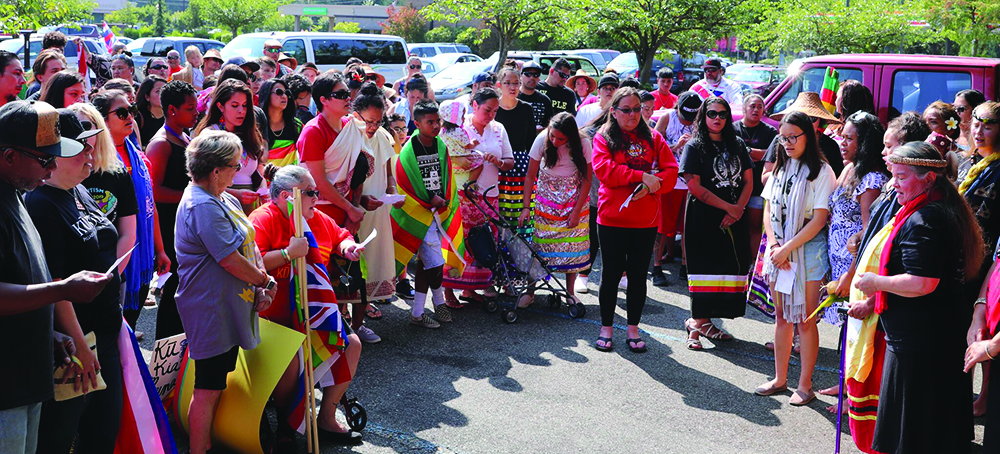
For over four hours, the two Indigenous communities banned together to raise awareness, receiving plenty of support from both local commuters and I-5 traffic. Throughout the afternoon the protectors received empathic honks, cries of support and some passengers even threw up the shaka sign out their windows to show solidarity. Among the many protectors was the Tulalip Youth Council who dedicated their entire Saturday to the movement.
“The Youth Council all felt it was important to be here,” said Council Member Marisa Joseph. “I like seeing everyone united for one cause. Having the youth here shows a strong message and shows that we can come together as one. It shows our love and how strong we are together.”
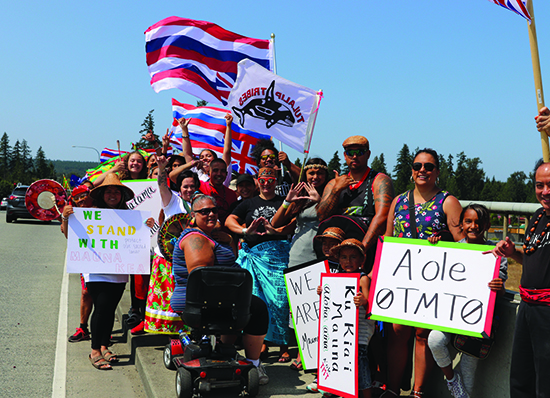
On the other side of the freeway, in the vacant lot across from the Bank of America, a canopy was set up for the protectors to get a little shade from the hot sun as well as to replenish with ice cold water and enjoy Hawaiian delectables, such as musubi, catered by Bobby’s Hawaiian Style Restaurant. A group of Tulalip drummers also brought awareness to drivers hopping onto the freeway or crossing the overpass, by holding up signs and singing traditional Tulalip songs. Tulalip tribal member and Mauna Kea Rally Organizer, Sara Hart, proudly sang while draped in her Coast Salish garb. Sara recently returned to the Pacific Northwest after traveling to Mauna Kea to stand with the people of Hawaii.
“For me, this is a huge movement,” stated Sara. “Indigenous people uniting together is beautiful. We need to stand together and fight for our sacred lands and waters; together we’re stronger. When I went over there it was the most unity I’ve ever felt, the most love I ever felt. Being there every day for protocol, singing with them and feeling that love and unity was amazing and to see that happen here today was very moving and beautiful. I think it’s important to learn their protocol and also bring ours to the table, so we’re accepting of one another and we’re opening up the floor in a good way.
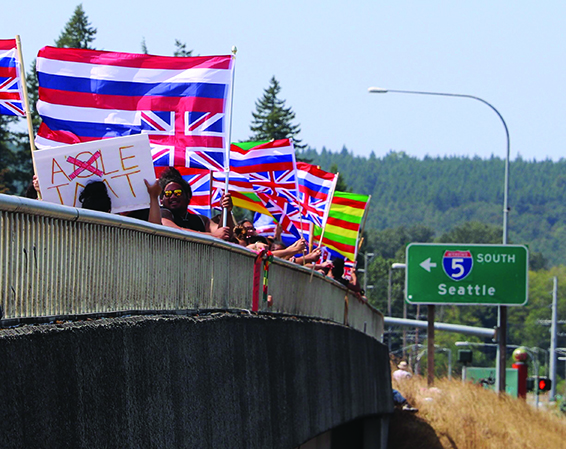
“I would like the protectors of Mauna Kea to know that we here in Tulalip and our surrounding communities are continuously sending love and prayers every day for them to protect the mountain and to protect themselves. That is their church, that is their holy place and that telescope doesn’t belong there.”
Due to the amount of growing support, the Hawaii Island City Council recently passed a sixty-day construction moratorium. In response, Governor Ige canceled the emergency proclamation but granted a two-year extension for the start of the TMT construction. Though the fight is far from finished, the kia’i have successfully prolonged the construction of the telescope for the time being. A small victory that speaks volumes.
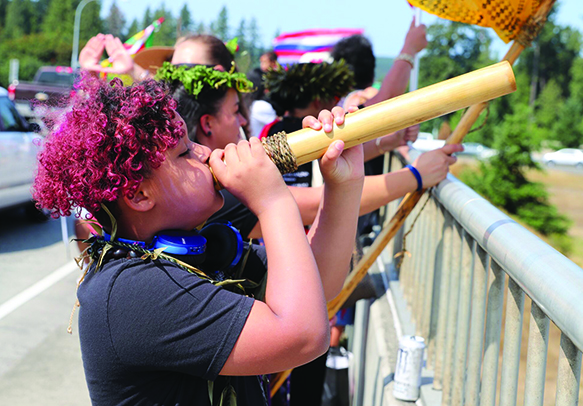
“It tells me that people see us, that we’re not invisible,” Gerry tearfully expressed. “For far too long we’ve been made invisible; our voices have been shut down. We’re seen as others, we’re seen as people who cause trouble, that we should just shut up and let people do what they want with our lands. What’s happening over at Mauna Kea has been going on for quite a while now. About three weeks ago, when our kūpuna were being arrested, we saw what was really happening on the islands and we knew we had a call we needed to make to our fellow Indigenous people. I honestly didn’t know how many people would show up today, I was not expecting this many. Seeing Native Americans and Native Hawaiians, people of the land, come together to rise up and stand in solidarity — my heat’s full. It makes me feel happy, joyful, and most of all, hopeful.”
If you would like to support the kai’i of Mauna Kea with monetary funds, warm clothing, medical supplies and more, a number of organizations can be found at www.ProtectMaunaKea.net.